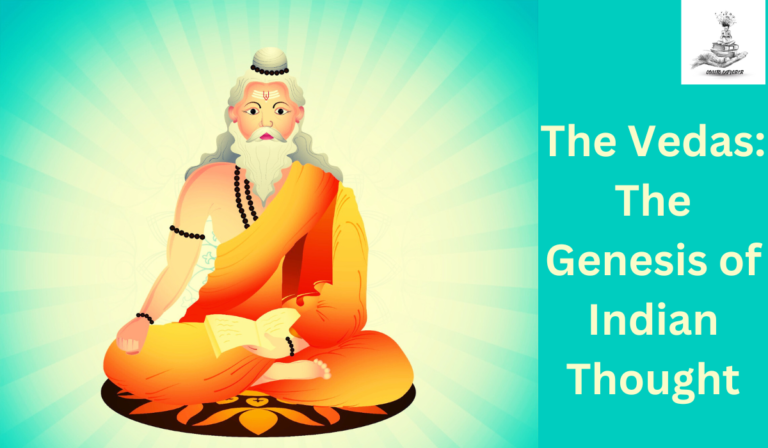RIGVEDA: The First Scripture
The Rigveda is one of the oldest and most important texts in the Vedas. Written in Vedic Sanskrit (an ancient form of the Sanskrit) it consists of the hymns. It is highly revered in Hinduism and is considered the foundation of Vedic literature.The Rigveda, with its rich poetry and profound philosophical ideas, holds a central place in the religious and cultural heritage of Sanatana Dharma. It is often recited during religious ceremonies and is central to the understanding of Vedic philosophy and the early development of Hindu religious practices.

Let us explore its parts as discussed in our previous article The Vedas: The Genesis of Indian Thought:
Rigveda Samhita:
The term Samhita refers to a collection of hymns (Suktas) or mantras. The Rigveda Samhita consists of 1,028 Suktas and is the oldest and most authoritative collection of hymns. Composed around 1500–1200 BCE the Samhita contains Suktas that praise and invoke various deities such as Agni (the fire god), Indra (the king of gods and god of thunder and rain), Varuna (god of cosmic order), and many others. These are traditionally attributed to various sages or seers (rishis) who are said to have received divine knowledge during moments of deep meditation. The most commonly mentioned rishis is Vyasa, who is traditionally credited with compiling the Vedas. The Suktas are written in a poetic and metrical form, and they often follow specific meters, such as Trishtubh and Gayatri. The poetic nature of the hymns contributes to their memorability and oral transmission.
While the Rigveda Samhita primarily focuses on hymns and prayers, it also contains the seeds of philosophical ideas that later develop into more complex philosophical systems in the Upanishads. It also provides insights into the social, cultural, and economic aspects of the early Vedic society. It describes various rituals, customs, and beliefs prevalent at that time.
It is organized into ten books called Mandalas, and each Mandala is further divided into hymns and verses.
Mandala 1: This Mandala has 191 hymns, and it is one of the largest Mandalas. It includes hymns addressed to Agni, Indra, Varuna, and other deities.
Mandala 2: Mandala 2 contains 43 hymns. It includes invocations to Agni, Indra, Varuna, and others.
Mandala 3: With 62 hymns, Mandala 3 focuses on Agni, the fire god, as well as other deities. It includes hymns that address various aspects of creation and cosmic order.
Mandala 4: This Mandala comprises 58 hymns dedicated to Agni, Indra, and other deities. It also includes philosophical hymns contemplating the nature of the divine and the universe.
Mandala 5: Mandala 5 has 87 hymns. It includes hymns dedicated to Agni, Indra, and other deities, as well as philosophical hymns contemplating the nature of the cosmos.
Mandala 6: With 75 hymns, Mandala 6 is primarily dedicated to the Maruts, the storm deities associated with Indra. It also includes hymns to Agni, Varuna, and others.
Mandala 7: Mandala 7 comprises 104 hymns. It includes hymns dedicated to Agni, Varuna, Indra, and other deities. This Mandala also contains the famous Devi Sukta, a hymn to the divine feminine.
Mandala 8: With 103 hymns, Mandala 8 is one of the longer Mandalas. It includes hymns to various deities, including Agni, Indra, Varuna, and the Asvins (twin deities associated with healing).
Mandala 9: Mandala 9 has 114 hymns. It includes invocations to Agni, Indra, Varuna, and other deities. Some hymns in this Mandala are dedicated to the All-Gods (Vasus, Rudras, Adityas, etc.).
Mandala 10: The last Mandala consists of 191 hymns, making it one of the largest. It includes a variety of hymns dedicated to different deities and addresses a wide range of topics, including cosmology and philosophy. The famous Purusha Sukta, describing the cosmic man, is found in this Mandala.
Each Mandala reflects a different thematic focus and includes hymns dedicated to various deities. The Rigveda, as a whole, covers a broad spectrum of subjects, ranging from prayers for material prosperity to contemplations on the nature of the divine and the universe. The arrangement of the Mandalas may not necessarily follow a chronological order, and each Mandala is somewhat independent in its content and themes.
The Brahmanas (Karmakanda)
The Brahmanas are prose texts associated with each Veda, providing explanations and instructions for the rituals and ceremonies mentioned in the Samhitas. In the case of the Rigveda, the Brahmanas associated with it are known as the Brahmanas of the Rigveda. These texts form a crucial part of the Vedic literature, offering insights into the ritualistic and sacrificial aspects of ancient Vedic practices. There are two main, among many other Brahmanas associated with the Rigveda: the Aitareya Brahmana and the Kaushitaki Brahmana.
Aitareya Brahmana
The Aitareya Brahmana is part of the Shakala Shakha (recension) of the Rigveda. It is composed in prose and is considered one of the earliest Brahmanas. It is divided into eight books or sections, commonly referred to as Ashtakas.
First Ashtaka: The first Ashtaka deals with the initiation of a student into Vedic studies. It provides details about the Upanayana ceremony, which marks the beginning of a student’s formal education under a guru.
Second Ashtaka: The second Ashtaka continues with discussions related to the initiation ceremony and introduces the concepts of Brahma and the creation of the world. It includes philosophical reflections on the nature of reality.
Third Ashtaka: The third Ashtaka focuses on the symbolic significance of the human body and its relationship to the cosmic order. It contains explanations regarding the performance of various rituals and sacrifices.
Fourth Ashtaka: The fourth Ashtaka delves into the details of the Soma sacrifice, one of the most significant rituals in the Vedic tradition. It provides instructions on the preparation of the ritual and the significance of its various components.
Fifth Ashtaka: The fifth Ashtaka continues the discussion on the Soma sacrifice and introduces various hymns and mantras associated with the ritual. It emphasizes the importance of correct pronunciation and performance of the rituals.
Sixth Ashtaka: The sixth Ashtaka contains discussions related to the importance of Agni (fire) in Vedic rituals. It elaborates on the role of Agni as a divine intermediary between the human and the divine realms.
Seventh Ashtaka: The seventh Ashtaka focuses on the rituals associated with the construction and consecration of the fire altar (agni-vedi). It provides detailed instructions on the precise measurements and arrangements of the altar.
Eighth Ashtaka: The eighth Ashtaka concludes the Aitareya Brahmana. It contains additional details about the construction of the fire altar and the performance of rituals. It also includes philosophical reflections on the nature of the divine.
The Aitareya Brahmana explains the ritualistic significance of various hymns from the Rigveda, especially those used in the Agnistoma and Ashvamedha sacrifices. It provides details about the performance of these rituals, including the construction of altars (Vedi) and the recitation of specific mantras.
Kaushitaki Brahmana:
Similar to the Aitareya Brahmana, the Kaushitaki Brahmana is also composed in prose and provides explanations and instructions for Vedic rituals. It elaborates on the significance of various rituals, mantras, and sacrificial ceremonies.
The Kaushitaki Brahmana is associated with the Rigveda and is part of the Shankhayana Shaka (recension) of the Rigveda. It is a prose text that provides explanations, instructions, and discussions related to Vedic rituals, philosophical concepts, and cosmological ideas. The Kaushitaki Brahmana is divided into three main sections known as “Kandas.”
First Kanda: This section primarily deals with the initiation ceremony (Upanayana) and other rituals. It provides details about the construction of altars (Vedi) and the performance of various sacrifices.
Second Kanda: The focus of this section is on the Soma sacrifice, one of the most significant rituals in the Vedic tradition. It contains instructions, explanations, and discussions including details about the rituals, mantras, and practices involved.
Third Kanda: This section continues the discussion on the Soma sacrifice and provides further details about the rituals and mantras associated with it. It may also contain additional philosophical and cosmological reflections.
The Kaushitaki Brahmana, like other Brahmanas, offers detailed insights into Vedic rituals. It provides instructions on the correct performance of ceremonies, the construction of altars, and the chanting of specific mantras. Alongside its focus on rituals, the Kaushitaki Brahmana includes passages that delve into philosophical and cosmological themes. It explores ideas related to the nature of the cosmos, creation, and the relationship between the individual (Atman) and the ultimate reality (Brahman).
The Brahmana serves an educational purpose, guiding priests and students in the study and practice of Vedic rituals. It reflects the structured transmission of Vedic knowledge within the ancient educational system.
Aranyakas (Upasana Kanda)
The term Aranyaka itself means ‘pertaining to the forest’, suggesting that these texts were intended for study and contemplation in a forest, solitaire or secluded setting. They often contain discussions on meditation, symbolism, and philosophical reflections. The Aranyakas serve as a bridge between the ritualistic Brahmanas and the speculative, philosophical Upanishads. Regarding the Rigveda, each of its Shakas (will be discussed soon) has its own associated Aranyaka. Let us explore some of them here:
Aitareya Aranyaka: The Aitareya Aranyaka is associated with the Shakala Shakha of the Rigveda. The Aitareya Aranyaka is significant for its philosophical content, and it is considered one of the earliest examples of Vedic speculative thought. It contains discussions on cosmology, meditation, and the nature of the individual soul (Atman).
Kaushitaki Aranyaka: The Kaushitaki Aranyaka is associated with the Shankhayana Shakha of the Rigveda. Like other Aranyakas, it contains both ritualistic and speculative elements. It discusses rituals, sacrificial ceremonies, and philosophical concepts related to meditation and the nature of the self.
These Aranyakas are often considered part of the larger Aranyaka literature associated with the respective Vedic Shakas. They are closely connected with the Brahmanas, and together, form a distinct portion of Vedic literature. While the Brahmanas are primarily concerned with rituals and ceremonies, the Aranyakas introduce more contemplative and symbolic elements. The Upanishads, which often follow the Aranyakas, delve even deeper into these speculative and philosophical themes, leading to the foundation of Vedanta philosophy.
The transition from the more external rituals of the Brahmanas to the contemplative and symbolic aspects in the Aranyakas reflects an evolution in Vedic thought. Along with the Upanishads, they mark a shift from the external ritualism of the early Vedic literature to a more introspective and philosophical exploration of reality and the self.
Upanishads (Gyan Kanda)
The Upanishads are a genre of philosophical and speculative texts that form the culmination of Vedic thought. They explore profound metaphysical and spiritual concepts, delving into the nature of reality, the self (Atman), and the ultimate reality (Brahman). While the Upanishads are not directly part of the Samhitas (hymns) of the Vedas, they are considered the concluding part of the Vedic literature. Each Veda has its own set of associated Upanishads, and the Upanishads associated with the Rigveda are known as the Rigveda Upanishads.
Some of the notable Upanishads associated with the Rigveda are:
Aitareya Upanishad: This Upanishad is closely linked with the Aitareya Aranyaka and the Aitareya Brahmana, both associated with the Rigveda. It explores the nature of the self (Atman) and its relationship with the ultimate reality (Brahman).
Kaushitaki Upanishad: Associated with the Kaushitaki Aranyaka and the Kaushitaki Brahmana of the Rigveda, this Upanishad includes speculative discussions on the nature of the self and the cosmos. It is also known for its reflections on meditation and the pursuit of knowledge.
Maitri Upanishad: While the Maitri Upanishad is often associated with the Yajurveda, it is also found in some manuscripts of the Rigveda. It explores concepts of Brahman, the self, and the nature of existence.
Brihadaranyaka Upanishad: This Upanishad is associated with the Shukla Yajurveda but is also considered part of the YajurVeda tradition associated with the Rigveda. It is one of the longest and most important Upanishads, discussing various philosophical themes, including the identity of the self with Brahman.
Chandogya Upanishad: While the Chandogya Upanishad is primarily associated with the Samaveda, it is also found in some manuscripts of the Rigveda. This Upanishad is known for its profound discussions on the syllable Om, the nature of reality, and the relationship between the individual soul (Jivatman) and the ultimate reality (Brahman).
These Upanishads, along with others associated with the Rigveda, form a crucial part of the philosophical literature of ancient India. They have had a profound influence on Hindu philosophy, shaping the doctrines of Vedanta and providing the foundation for spiritual inquiry and meditation. The Upanishads are revered as the concluding wisdom of the Vedic tradition and are considered the essence of spiritual teachings within Hinduism.
The Rigveda is the vast literature and along with its associated texts, it forms the base of ancient Indian Vedic Literature. In our following articles, we will be discussing different Sakhas of the Vedas and the concept of Charana, ways to read The Vedas.






